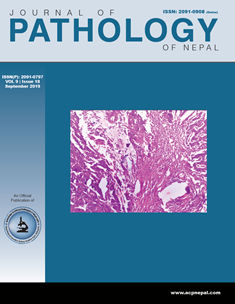Clinicopathological correlation of uterine cervical lesions with focus on premalignant and malignant lesions
DOI:
https://doi.org/10.3126/jpn.v9i2.26447Keywords:
Adenocarcinoma; Carcinoma; Cervical cancer; Precancerous Lesion; Unhealthy cervix;, Adenocarcinoma, Carcinoma, Cervical cancer, Precancerous Lesion, Unhealthy cervixAbstract
Background: Cervical cancer ranks as the most frequent cancer among women in Nepal and the first most frequent cancer among women between 15 and 44 years of age. The objectives of the study are to find the incidence of premalignant and malignant cervical conditions and to correlate histopathological diagnosis with that of clinical diagnosis.
Materials and Methods: This was a retrospective study carried out at Kathmandu University Hospital. All cervical biopsy done from January 2009 to December 2018, were included in the study. A proforma was created in which relevant demographic data like age, sex along with clinical findings, gross and histopathological findings were collected.
Results: Mean age of patients with cervical intraepithelial lesion- 1, 2 and 3 was 43.5 years, 48 years and 43.4 years respectively. The most common diagnosis was cervical polyp were (38.65%) followed by 52 cases (15.9%) of unhealthy cervix which bleeds easily on touch and 42 (12.8%) cases of inflammatory condition. Clinical diagnosis of carcinoma of cervix comprised of 42 cases (12.8%). On histopathology, 51(15.6%) cases had invasive carcinoma of which 48 (94.1%) were squamous cell carcinoma, two (3.92%) were adenocarcinoma, and one (1.9%) was of small cell carcinoma. In 33 cases (78.57%), clinical examination was correctly able to identify the invasive cancer. The sensitivity rate of diagnosing cancerous and precancerous lesions by clinical examination and cervical pap smear was 80.95 percent.
Conclusions: Proper clinical history, examination, pap smearing and biopsy report helps through appropriate clinical intervention and prevents development of advanced stage of cervical carcinoma
Downloads
Downloads
Published
How to Cite
Issue
Section
License
This license enables reusers to distribute, remix, adapt, and build upon the material in any medium or format, so long as attribution is given to the creator. The license allows for commercial use.




